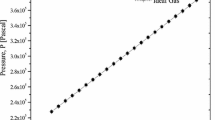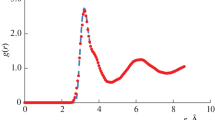Abstract
The anisotropic thermal conductivity of helium–xenon binary nanocrystal superlattices (BNSLs), which are stoichiometric solid structures Xe(He)2 and Xe(He)13, at high pressure and room temperature (T = 300 K), respectively, has been calculated by equilibrium molecular dynamics (EMD) simulation using the Green–Kubo formalism and the exponential-6 intermolecular potential under periodic boundary conditions (PBC). The pressures obtained from EMD agree very well with those from an independent study, to within 5 %. Nonequilibrium molecular dynamics (NEMD) simulation is also carried out for comparison. The thermal conductivities predicted by NEMD are of the same order of magnitude as the results predicted by EMD. The anisotropic thermal conductivities of stoichiometric solid structures (Xe(He)2 and Xe(He)13) with different molar volume and atomic number are investigated, and results show that the thermal conductivities of Xe(He)2 are more strongly anisotropic than those of Xe(He)13, whereas the averaged thermal conductivities of Xe(He)2 are around one tenth (1/10) of those of Xe(He)13, indicating that the thermal conductivities of helium–xenon BNSLs (Xe(He)2 and Xe(He)13) significantly depend on the molecular structure in both magnitude and anisotropy. The results also show that both the magnitude and anisotropy of the thermal conductivity of helium–xenon BNSLs (Xe(He)2 and Xe(He)13) slightly depend on the atomic number and molar volume of the simulation system, with finite-size effects existing in the nanoscale system.
Similar content being viewed by others
References
Sanders J.V.: Philos. Mag. A 42, 705 (1980)
Murray M.J., Sanders J.V.: Philos. Mag. A 42, 721 (1980)
Shevchenko E.V., Talapin D.V., Rogach A.L., Kornowski A., Haase M., Weller H.: J. Am. Chem. Soc. 124, 11480 (2002)
Redl F.X., Cho K.-S., Murray C.B., O’Brien S.: Nature 423, 968 (2003)
Shevchenko E.V., Talapin D.V., Murray C.B., O’Brien S.: J. Am. Chem. Soc. 128, 3620 (2006)
T.D. Ewers, A.K. Sra, Q. Xu, H. Zandbergenb, R.E. Schaak, Chem. Commun. (2006). doi:10.1039/b515673d
Evans D.J., Morriss G.P.: Comput. Phys. Rep. 1, 297 (1984)
Barrat J.-L., Vos W.L.: J. Chem. Phys. 8, 5707 (1997)
A.N. Bodapati, Structural Disorder and Thermal Transport in Nanoscale Solids, Dissertation, Rensselaer Polytechnic Institute, 2006, available via DIALOG, http://proquest.calis.edu.cn, cited 15 Dec 2008
Volz S.G., Chen G.: Phys. Rev. B 61, 2651 (2000)
M.P. Allen, Introduction to Molecular Dynamics Simulation (University of Warwick, UK, 2004), available via DIALOG, http://www.fz-juelich.de/nic-series/volume23/allen.pdf, cited 15 Dec 2008
Schelling P.K., Phillpot S.R., Keblinski P.: Phys. Rev. B 65, 144306 (2002)
T. Sirk, Numerical Simulation of Nanoscale Flow: A Molecular Dynamics Study of Drag, Thesis, Virginia Polytechnic Institute and State University, Blacksburg, VA, 2006, available via DIALOG, http://scholar.lib.vt.edu/theses/available/etd-05042006-190812/unrestricted/SIRK.pdf, cited 15 Dec 2008
Schofield A.B., Pusey P.N., Radcliffe P.: Phys. Rev. E 72, 031407 (2005)
N. Ogbonna, Molecular Dynamics Simulation, Post-graduate Diploma Essay, African Institute for Mathematical Sciences, South Africa, 2004, available via DIALOG, http://users.aims.ac.za/~nneoma/theses/NneomaAimsEssay.pdf, cited 15 Dec 2008
Choi S.-H., Maruyama S.: Int. J. Therm. Sci. 44, 547 (2005)
McGaughey A.J.H., Kaviany M.: Phys. Rev. B 69, 094303 (2004)
Ladd A., Moran B., Hoover W.G.: Phys. Rev. B 34, 5058 (1986)
W.C.W. Fon, Thermal Properties of Nano- and Microstructures, Dissertation, California Institute of Technology, Pasadena, CA, 2004, available via DIALOG, http://etd.caltech.edu/etd/available/etd-05262004-123035/unrestricted/Thesis.pdf, cited 15 Dec 2008
Chen Y., Lukes J.R., Yang J., Wu Y.: J. Chem. Phys. 120, 3841 (2004)
Y. Hudiono, Thermal Transport Properties of Nanoporous Zeolite Thin Films, Dissertation, Georgia Institute of Technology, Atlanta, GA, 2008, available via DIALOG, http://etd.gatech.edu/theses/available/etd-07032008-122258/unrestricted/Hudiono_yeny_200808_phd.pdf, cited 15 Dec 2008
J.D. Chung, A.J.H. McGaughey, M. Kaviany, ASME J. Heat Transfer (2004). doi:10.1115/1.1723469
I. Soroka, Magnetic Heterostructures: The Effect of Compositional Modulation on Magnetic Properties, Dissertation, Uppsala University, Sweden, 2005, available via DIALOG, http://www.diva-portal.org/diva/getDocument?urn_nbn_se_uu_diva-5733-2__fulltext.pdf, cited 15 Dec 2008
Author information
Authors and Affiliations
Corresponding author
Rights and permissions
About this article
Cite this article
Bai, D. Molecular Dynamics Study on the Anisotropic Thermal Conductivity of Helium–Xenon Binary Nanocrystal Superlattices. Int J Thermophys 30, 919–933 (2009). https://doi.org/10.1007/s10765-009-0577-3
Received:
Accepted:
Published:
Issue Date:
DOI: https://doi.org/10.1007/s10765-009-0577-3




